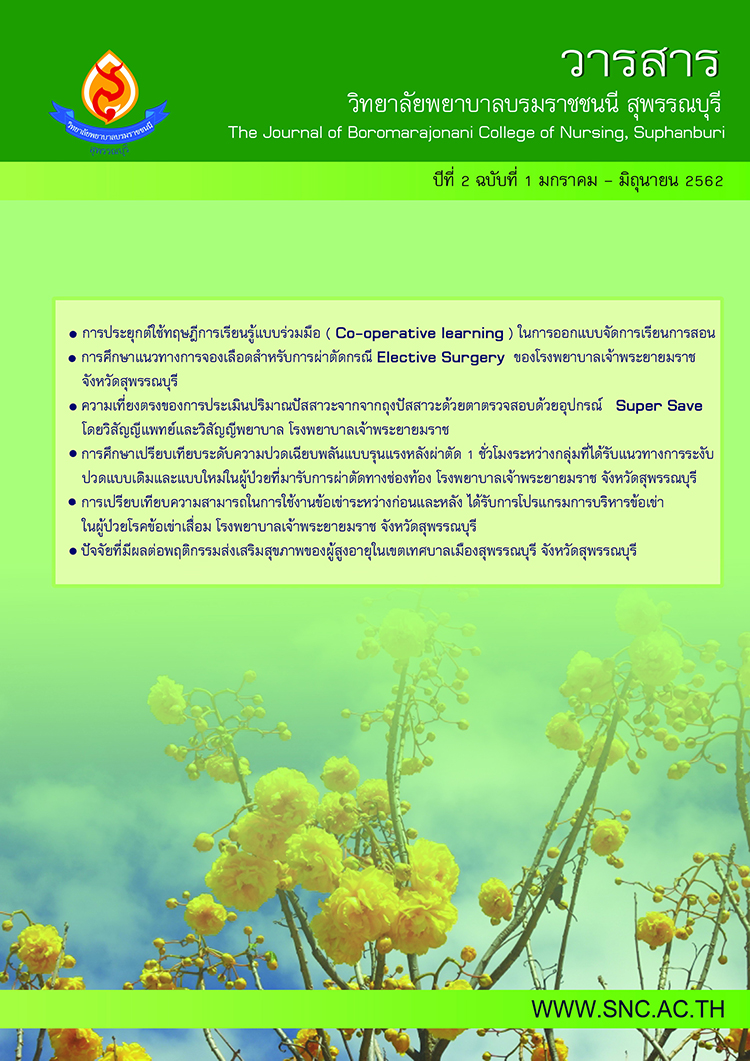การศึกษาแนวทางการจองเลือดสำหรับการผ่าตัดกรณี Elective Surgery ของโรงพยาบาลเจ้าพระยายมราช จังหวัดสุพรรณบุรี
คำสำคัญ:
Elective surgery, Crossmatch-to-transfusion Transfusion, Transfusion probability, Transfusion index, Type and screen Original Articleบทคัดย่อ
ปัจจุบันการขอใช้เลือดในผู้ป่วยผ่าตัดชนิด Elective surgery มีแนวโน้มเพิ่มขึ้น อาจจะส่งผลกระทบให้มีปริมาณเลือดไม่เพียงพอกับความต้องการ จึงควรพัฒนาแนวทางการใช้เลือดที่เหมาะสม โดยใช้ตัวชี้วัด 3 ชนิดคือ Crossmatch-to-transfusion (C:T ratio), Transfusion probability (%T) และ Transfusion index (Ti) เพื่อศึกษาการใช้เลือดและแนวทางการเตรียมเลือดที่เหมาะสมสำหรับผู้ป่วยผ่าตัด elective surgery ในโรงพยาบาลเจ้าพระยายมราช ได้ศึกษาข้อมูลผู้ป่วยผ่าตัด elective surgery ย้อนหลัง 5 เดือนโดยเก็บข้อมูลทั่วไปและการสั่งจองเลือดของผู้ป่วย จากการวิเคราะห์ข้อมูลจากดัชนีชี้วัด C:T ratio, %T และ Ti ผลการศึกษา ผู้ป่วยผ่าตัด elective surgery จำนวน 1,304 ราย แพทย์สั่งเตรียมเลือดจำนวน 2,359 ยูนิต แต่มีเพียง 263 ราย ที่ใช้เลือดจริง 494 ยูนิต (C:T ratio = 4.78, %T = 20.2, Ti = 0.37) ซึ่งผู้ป่วยผ่าตัดกระดูกและข้อมีการจองเลือดมากที่สุด (C:T ratio =2.99, %T = 27.8, Ti = 0.53) รองลงมาคือผู้ป่วยผ่าตัดศัลยกรรม (C:T ratio = 5.55, %T =19.25, Ti = 0.35) และผู้ป่วยสูตินรีเวช (C:T ratio =17.9, %T = 6.25, Ti = 0.11) เมื่อวิเคราะห์ข้อมูลโดยใช้แนวทางการเตรียมเลือดแบบ type and screen (T&S) พบว่าช่วยประหยัดค่าใช้จ่ายการตรวจ complete crossmatch 102,080 บาท และลดภาระงานได้ 234 ชั่วโมง
สรุป จากการศึกษาย้อนหลังผู้ป่วยผ่าตัด elective surgery ของโรงพยาบาลเจ้าพระยายมราชมีการสั่งจองเลือดเกินความต้องการใช้จริง จึงควรเลือกใช้แนวทางการสั่งจองเลือดที่มีประสิทธิภาพ เพื่อลดการสูญเสียทรัพยากรและค่าใช้จ่ายที่เกิดจากการเตรียมเลือด ส่งผลให้มีปริมาณเลือดหมุนเวียนและเลือดสำรอง คงคลังเพียงพอในกรณีฉุกเฉิน
เอกสารอ้างอิง
Fung MK, Grossman BJ, Hillyer CD, Westhoff CM. (2014). Technical manual. 18thed. Bethesda: AABB.
National Blood Centre, Thai Red Cross Society. (2015). Standards for blood banks and transfusion service. 4thed. Bangkok: Udomsuksa.
Saipin J. (2012). Compatibility testing: A Review. J Hematol Transfus Med.; 20 : 89-91.
Boral L, Henry JB. (1977). The type and screen: A safe alternative and supplement in selectedsurgicalprocedures.Transfusion. 17: 163-8.
Tiloklurs M, Klunklin G, Yimsabai J. (2007). Reduction the cost of blood preparation for transfusion in surgical patients by type and screen. Buddhachinraj Med J.; 24: 49-51.
Wong L, Cheng G. (1995). Type and screen of blood units at a teaching hospital. Hong Kong Med J.; 1: 27-30.
Brecher ME. Technical Manual. (2005). 15thed.
Bethesda: American Association of Blood Banks. Mead JH, Anthony CD, Sattler M. (1980). Hemotherapy in elective surgery: an incidence report, review of literature, and alternatives for guideline appraisal. Am J Clin Path.; 74 : 223-7.
Friedman BA, Oberman HA, Chadwick AR, Kingon KI. (2011). The maximum surgical blood order schedule and surgical blood use.755-9
Ibrahim SZ, Mamdouh HM, Ramadan AM. (2011). Blood utilization for elective surgeries at main University Hospital in Alexandria, Egypt. J Amer Sci.;7: 683-9.
Panichakul K,Changsam K, Chau-in W, Wongswadiwat M, Sumanont S. (2014). An appropriate use of routine crossmatch of preoperative blood preparation for elective knee and hip surgery. Srinagarind Med J.; 29: 423-8.
Wongaek J, Lewsirirat S, Piyapromdee U. (2015). Blood utilization for elective orthopaedic surgeries at Maharat Nakhon Ratchasima Hospital. Orthopedic Surgery J.; 39: 17-24.
Trakulkasamsiri S. (2007). Cost reduction of crossmatching by type and screen protocol in Obstetrics patients at Queen Savang Vadhana Memorial Hospital, Thai Red Cross Society. Bull Chiang Mai Assoc Med Sci. 40: 114-117.
Chanachaisuwan P. (2010). Utilization in elective surgery at Police general hospital. Hematol Transfus Med J.; 20: 93-104.
Chawla T, Kakepoto GN, Khan MA. (2001). An audit of blood cross match ordering practices at the Aga Khan University Hospital: first step towards a Maximum Surgical Blood Ordering Schedule.J Pak Med Assoc.; 51: 379.
Jensen BA. (1992). Rational blood reservation for elective surgery. A prospective evaluation of blood reservation, use of transfusions and resources. Ugeskr Laeger.; 154: 850-5.
ดาวน์โหลด
เผยแพร่แล้ว
ฉบับ
ประเภทบทความ
สัญญาอนุญาต
ลิขสิทธิ์ (c) 2019 วิทยาลัยพยาบาลบรมราชชนนี สุพรรณบุรี

อนุญาตภายใต้เงื่อนไข Creative Commons Attribution-NonCommercial-NoDerivatives 4.0 International License.
บทความที่ได้รับการตีพิมพ์เป็นลิขสิทธิ์ของวารสารวิทยาลัยพยาบาลบรมราชชนนี สุพรรณบุรี
ข้อความที่ปรากฏในบทความแต่ละเรื่องในวารสารวิชาการเล่มนี้เป็นความคิดเห็นส่วนตัวของผู้เขียนแต่ละท่านไม่เกี่ยวข้องกับวิทยาลัยพยาบาลบรมราชชนนี สุพรรณบุรี และคณาจารย์ท่านอื่นๆในวิทยาลัยฯ แต่อย่างใด ความรับผิดชอบองค์ประกอบทั้งหมดของบทความแต่ละเรื่องเป็นของผู้เขียนแต่ละท่าน หากมีความผิดพลาดใดๆ ผู้เขียนแต่ละท่านจะรับผิดชอบบทความของตนเองแต่ผู้เดียว



